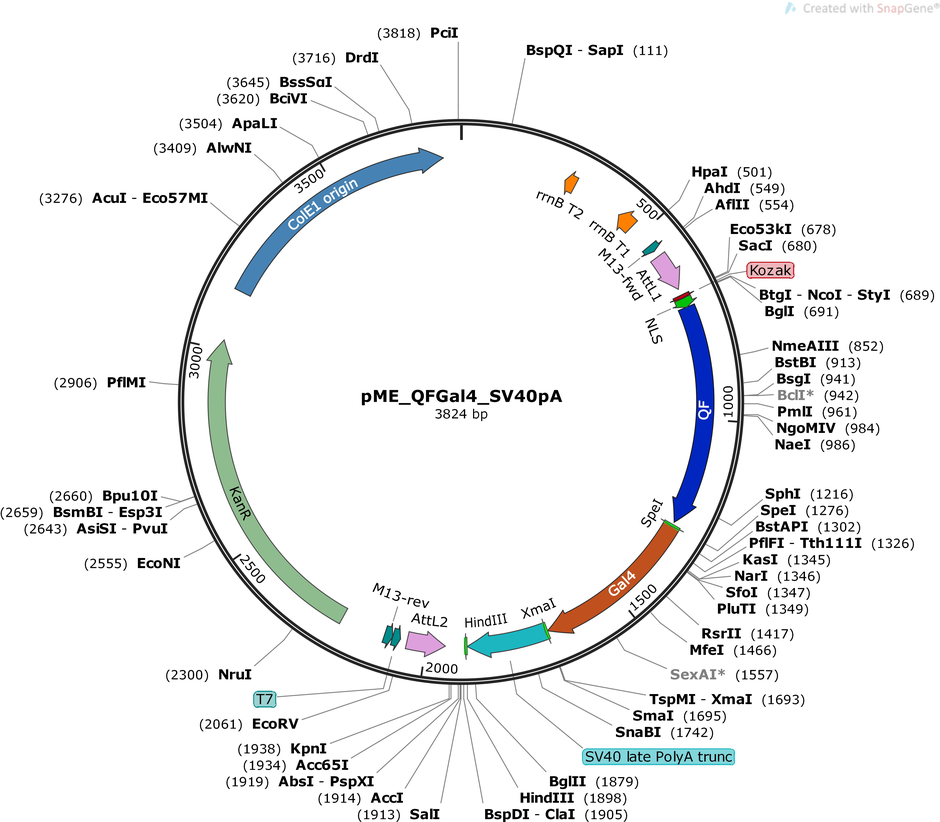pME-QFGal4-SV40pA
(Plasmid
#155118)
-
PurposeMiddle entry vector containing QFGal4
-
Depositing Lab
-
Sequence Information
Ordering
| Item | Catalog # | Description | Quantity | Price (USD) | |
|---|---|---|---|---|---|
| Plasmid | 155118 | Standard format: Plasmid sent in bacteria as agar stab | 1 | $85 | |
Backbone
-
Vector backbonepDONR221
-
Backbone manufacturerInvitrogen
- Backbone size w/o insert (bp) 2544
- Total vector size (bp) 3824
-
Vector typeGateway middle entry vector
Growth in Bacteria
-
Bacterial Resistance(s)Kanamycin, 50 μg/mL
-
Growth Temperature37°C
-
Growth Strain(s)DH5alpha
-
Copy numberHigh Copy
Gene/Insert
-
Gene/Insert nameQFGal4
-
SpeciesS. cerevisiae (budding yeast); Neurospora crassa
-
Insert Size (bp)1280
-
GenBank ID855828 3875756
Cloning Information
- Cloning method Restriction Enzyme
- 5′ cloning site SacI (not destroyed)
- 3′ cloning site HindIII (not destroyed)
- 5′ sequencing primer CAC GAC GTT GTA AAA CGA C
- 3′ sequencing primer CAG GAA ACA GCT ATG AC (Common Sequencing Primers)
Resource Information
-
Supplemental Documents
Terms and Licenses
-
Academic/Nonprofit Terms
-
Industry Terms
- Not Available to Industry
Trademarks:
- Zeocin® is an InvivoGen trademark.
Depositor Comments
Can be recombined with any p5E vector containing a promoter to allow for tissue-specific expression of QFGal4. Note that an SV40pA is included after QFGal4.
These plasmids were created by your colleagues. Please acknowledge the Principal Investigator, cite the article in which the plasmids were described, and include Addgene in the Materials and Methods of your future publications.
-
For your Materials & Methods section:
pME-QFGal4-SV40pA was a gift from Bret Pearson (Addgene plasmid # 155118 ; http://n2t.net/addgene:155118 ; RRID:Addgene_155118) -
For your References section:
An optimized QF-binary expression system for use in zebrafish. Burgess J, Burrows JT, Sadhak R, Chiang S, Weiss A, D'Amata C, Molinaro AM, Zhu S, Long M, Hu C, Krause HM, Pearson BJ. Dev Biol. 2020 Jul 19. pii: S0012-1606(20)30202-5. doi: 10.1016/j.ydbio.2020.07.007. 10.1016/j.ydbio.2020.07.007 PubMed 32697972






